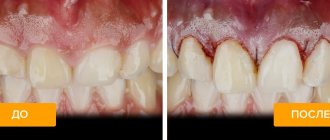Author of the article:
Soldatova Lyudmila Nikolaevna
Candidate of Medical Sciences, Professor of the Department of Clinical Dentistry of the St. Petersburg Medical and Social Institute, Chief Physician of the Alfa-Dent Dental Clinic, St. Petersburg
Expecting relief from pain from going to the dentist, patients sometimes leave the office confused - why hasn’t the pain completely gone away? It can be present for several hours or last much longer.
Why does a tooth hurt after filling?
The filling that the doctor places on the treated tooth should exclude the possibility of disease. If you feel pain after filling, the reason may be:
- The body's natural reaction to outside interference. Even after proper treatment, such a phenomenon may occur, which is periodic in nature. The pain in this case does not increase or become too severe; it can last from 2 weeks to 2 months.
- Caries is not completely cured. The tooth tissues become inflamed, and the tooth hurts after filling with aching pain. In this case, it is necessary to contact the dentist again to prevent further complications - inflammation can affect the dental nerve (pulpitis develops).
- Chronic or developing pulpitis that was not identified during the diagnostic process before the start of treatment.
- Incomplete treatment of tissues affected by inflammation during periodontitis. Treatment of periodontitis is not limited to one day, it is quite complex.
- If the filling is installed incorrectly (either at an insufficient level, or is large and puts pressure on other teeth or gums). Often a tooth hurts after root canal filling for this very reason. Damage to the filling can occur due to insufficiently high quality filling material or failure to comply with the recommendations of the dentist.
- Slight pain may be felt due to tissue injury during the process of tooth filling. It will take some time for healing to occur.
- The sensitivity of teeth after filling always increases significantly, and discomfort, manifested in painful sensations, can be the result of insufficiently correct implementation of one of the treatment procedures - drying the inner dental walls (over-drying or under-drying). If the walls of the tooth are not completely dry when installing the filling, it does not adhere well in damp places, which leads to the development of inflammation and pain.
- Allergic reaction to the filling material.
It is much easier to identify pathologies after dental treatment if all the dentist’s advice and oral hygiene rules are followed.
Attention! Dentists recommend that their patients have a small snack before going to the dental office, so that due to the lack of glucose that occurs during treatment, fear and the vasoconstrictive effect of the drugs, they do not experience a semi-fainting state during the treatment.
How long after filling should I abstain from eating?
Modern fillings contain epoxy resin, which ensures that the new filling quickly hardens into the desired shape. Light-polymer fillings harden almost instantly, while those made from chemical materials take no more than an hour. Therefore, after filling a tooth, you can eat food immediately.
When installing a temporary filling, a longer period of time abstaining from eating is required - at least 2 hours.
Methods for relieving pain after tooth nerve removal
There is no need to worry if the tooth hurts when pressed and tapped, reacts to cold and hot, or discomfort occurs when the jaws are completely closed. You need to take pain medication after tooth nerve removal, which will be prescribed by your doctor. Usually these are Ketorol, Nimesil, Tempalgin, etc. Rinsing your mouth with water, baking soda, salt and iodine will help relieve minor pain.
If gum inflammation, fever, and pus discharge are added to the pain after nerve removal, you should consult a doctor.
My gums hurt after filling a tooth, what should I do?
If, after installing a filling, your gums are very sore and even your cheek is swollen, you cannot do without the help of a dentist. Moreover, it is necessary to contact as soon as possible so that there are no even more unpleasant consequences.
A few tips to relieve pain:
- applying an ice compress to the cheek at the sore spot for several minutes or a compress with ice cubes;
- alternate application of compresses with warm rinses from decoctions of medicinal herbs or infusions;
- painkillers.
Attention! Under no circumstances should you apply hot or warm compresses - they actively provoke inflammation and pain!
Taking antibiotics without a doctor's prescription is also extremely contraindicated, because this can lead to a decrease in immunity and complicate further treatment.
Preventive measures
After filling a tooth, during the first week, you must strictly follow the main rules so that pain does not occur, or it disappears as soon as possible:
- do not drink or eat too cold or too hot, as temperature changes provoke pain;
- every time after eating, brush your teeth and rinse your mouth with special anesthetic rinses (the ASEPTA series includes rinses with an analgesic and disinfecting effect);
- try to eat softer foods so as not to damage the periodontal tissues, and it is preferable to chew only on the healthy side;
- do not smoke, as the tooth disturbed by treatment is very sensitive in the first days.
Why does cheek swelling occur?
A common cause of edema is odontogenic periostitis, or gumboil. The inflammatory process of the periosteum is accompanied by the formation of purulent contents at the base of the root. The causes of gumboil are the spread of infection from a diseased tooth - carious or pulpy. In this case, only surgical treatment of periostitis, an incision in the gum and cleaning out the pus will help relieve swelling.
Another cause of cheek swelling is gingival cysts. If the cystic formation is localized not strictly under the root, but on the side, the gums and along with it the patient’s cheek swell. Getting rid of cysts involves performing tooth-preserving operations or, in advanced cases, tooth extraction. Often the cyst itself does not cause swelling, but after surgery to resect it, the patient receives swelling, which goes away within 2-3 days.
Patients with impacted and dystopic wisdom teeth often suffer from swelling during periods when the tooth is actively trying to erupt.
Experts' opinion
The effectiveness of the ASEPTA series products has been proven by multiple clinical trials conducted in the country's leading research institutes.
For example, a study of the clinical effectiveness of treatment and prophylactic agents from the Asepta line in the treatment of inflammatory periodontal diseases, conducted by A.I. Grudyanov, I.Yu. Alexandrovskaya, V.Yu. Korzunina in the Department of Periodontology of the Central Research Institute of Dentistry and Maxillofacial Surgery of Rosmedtekhnologii, Moscow, made it possible to identify the fairly high effectiveness of the Asepta gum balm and the Asepta mouth rinse for moderate periodontitis. The use of Asepta mouth rinse for inflammation also turned out to be quite effective. In addition, no phenomena of mucosal irritation or brown staining of fillings were recorded. This indicates that the use of this rinse for a two-week period provides an obvious clinical effect in the absence of negative side effects.
Cyst symptoms
The cyst develops asymptomatically for a long time. Sometimes it makes itself felt by aching pain when pressing on a sore tooth or when biting into hard food. It is easy to detect on plain X-rays.
When immunity decreases, the cystic infection can worsen and begin to actively produce pus. This process is accompanied by severe pain in the area of the corresponding tooth, sometimes by increased body temperature and swelling of the gums. The cheek becomes noticeably swollen, the person feels unwell and weak, urgent consultation and diagnosis are required, and then urgent treatment.
Consumer Reviews
Mrs. Doubtfire about Asepta Active mouth rinse (irecommend.ru):
“When I was faced with a serious gum problem, this rinse was recommended to me by a dental surgeon.
Asepta Active mouthwash is a medical product and is sold only through the pharmacy chain. The instructions recommend taking breaks in use. Personally, I use it in courses and during exacerbations of gum inflammation. I've been using it for about 2 years.
The mouthwash is minty, pleasant, slightly astringent. Improvement is felt from the first use. Bottle volume 150 ml. Manufacturer: Russia, St. Petersburg. A convenient measuring cup is included.
You can (better) buy it as a set, which also includes balm and toothpaste, which comes as a gift.
I’m very happy that such products from a domestic manufacturer have appeared!”
julia-06 about Asepta Active mouth rinse (irecommend.ru):
“A very good rinse for problem gums.
She had never encountered the problem of bleeding gums, but at her next visit to the dentist she noticed that when she only lightly touched her gums, they began to bleed. So the dentist gave me a mini version of Paradontax toothpaste and advised me to use a mouthwash after brushing my teeth. Mom bought Asepta active mouth rinse.
For some reason I used to be very skeptical about such remedies, but as it turned out, in practice it helps very well. My problem went away completely, my gums stopped bleeding. I don’t even want to read the ingredients and go into its details, it’s unlikely that everything is super natural, but since it helps, I give the mouthwash a solid 5 points. Of course, each case is individual, but I will recommend it based on my experience. And the price of the rinse aid is quite reasonable.”
Inflammation: where does it come from?
The most common cause of swollen gums is an inflamed tooth. In the vast majority of cases, swelling occurs as a result of chronic inflammation of the dental tissues under the crown and/or filling, lasting more than one day or even more than one week, against the background of progressive complicated untreated caries and/or after mechanical trauma to the mucous membrane.
Unfilled canals, improper treatment of caries - all this ultimately leads to gum swelling. Voids in the dental canals, perforation of the tooth root against the background of poor quality treatment involuntarily help the infection to spread further.
In this case, the swelling of the gums also affects the area of the diseased tooth, accompanied by a feeling of aching pain. For some people, the pain may be intermittent and only occur when biting.
The usual swelling of the gums can also hide such serious problems as a dental cyst or an abscess on the gum.
Treatment of dental cyst
Treatment of the cyst can be therapeutic and/or surgical.
Surgical treatment involves resection of the cyst.
Therapeutic treatment lasts a long time. The doctor has to remove the pulp and re-treat the canals with antiseptics. After this, a paste with a long-acting antiseptic is placed in them. In some cases, the treatment procedure requires repeated repetition.
After a course of therapy, an x-ray shows how effective the treatment was. If the cyst has significantly decreased in size, the canals can be filled with a permanent filling - gutta-percha.
After this, the patient should periodically visit the dentist to assess the dynamics of recovery.
When does tissue swelling indicate the development of a complication?
The norm and pathology during the development of edema are distinguished by positive dynamics. If it is not there, then the swelling not only does not subside after three to four days, but also increases, and other pathological symptoms intensify. The gums turn red, pain increases, and the body temperature remains elevated. The situation in which the swelling of the cheek first decreased and then reappeared was also outside the norm. The listed symptoms may indicate the development of an inflammatory process, so assistance from a dentist should be immediate.
Why does swelling appear?
Swelling of the cheeks, gums and facial tissues is normal. Swelling is the influx of fluid into damaged tissue. Lymph accumulates in the area of damage: this is how the natural processes of regeneration and protection of the body are launched.
The strength of the reaction depends on the individual characteristics of the organism. For example, there are people who had severe swelling in the upper jaw or lower jaw, and there are those who have a slight swelling in the gum. If your facial tissues are swollen, but nothing is bothering you, you do not need to see a doctor.
When can swelling be considered physiological?
As a rule, the patient notices swelling of the cheek within the first two to three hours after completion of surgical procedures. Swelling may be accompanied by pain, fever and last up to five to seven days. At the same time, starting from the third day, the swelling of the cheek begins to subside as the tissues heal. By the end of the first week, the size and proportions of the face are restored. This course of events is considered physiological and corresponds to the norm.
The healing and recovery process may take longer when multiple implants are installed or combined procedures are performed, such as bone augmentation. If the patient’s general condition is not impaired, then longer-term swelling of the cheek should not cause concern. But the final conclusion must be made by the dentist.
How to prevent pathological swelling after implant installation?
The following recommendations will help you avoid complications:
- Do not neglect cold compresses on the first day after surgery.
- It is important to take the medications prescribed by your dentist according to the prescribed regimen, without changing the dosage.
- To brush your teeth, use a soft brush without touching the wound.
- You should avoid stress, overload, temperature changes, and airplane flights.
Patients who follow the instructions and follow the doctor’s warnings are less likely to experience complications after implantation, and cheek swelling goes away much faster.
How can you reduce discomfort and ease your general condition?
Implantation is a trauma for the body. The procedure is performed quickly and with minimal risks to the patient, but the consequences should be expected. The installation of artificial roots requires high-quality postoperative oral care. This is necessary to relieve swelling and prevent the development of infection.
To reduce facial swelling after surgery, you must follow your doctor’s instructions:
- On the first day , apply cold to the side of the face where the operation was performed. Session duration is 5-10 minutes. Repeat the procedure at intervals of 20 minutes. A break is necessary to prevent hypothermia.
- Correctly position your head while sleeping . To prevent the blood from rushing to the head and the swelling from increasing, you need to sleep on a high pillow. Compliance with this measure is recommended for a week.
- Maintain oral hygiene. Treat teeth located near the operated area with a 3% hydrogen peroxide solution. The rest are cleaned in the standard way.
- Rinse your mouth with herbal decoctions . Oak bark, chamomile, and calendula relieve swelling well. The procedure is prescribed a few days after implantation, when the process of tightening the soft tissues has passed.
- Follow a postoperative diet. Do not eat hard, hot or spicy foods. Chopped food at room temperature is recommended.
Possible causes of swollen gums
To understand what to do if your gums are swollen, you first need to find out the cause of this process. As a rule, swelling and pain indicate an inflammatory process occurring near the apex of the tooth.
A focus of inflammation in the area of the upper part of the root can occur for several reasons:
- Poorly performed canal filling. Despite the fact that dentists have to do this procedure very often, not all dentists perform it at the proper level. In more than half of the cases, filling of dental canals is carried out with an error: either it is not done completely, or the doctor breaks the instrument during the procedure, or due to carelessness, perforation of the root occurs (small holes in it). The result of this is the formation of a purulent inflammatory focus (cyst), which develops into periodontitis.
- Ignoring caries, which developed as a result into pulpitis. If the resulting caries is not cured in time, pathogenic microorganisms will enter the pulp, and from there to the upper part of the root, where inflammation will begin, accompanied by the formation of pus. Sometimes swelling is a consequence of worsened inflammation of the gums (periodontitis, which has passed into the chronic stage). But this rarely happens: as a rule, only with existing deep pockets (4 mm or more). With a deep periodontal pocket, the normal outflow of pus is disrupted, and an abscess forms in the gum.
- If caries is not treated, the infection can penetrate into the bone tissue through the dental canal, causing swelling.
- Sinusitis and various diseases affecting the throat (inflammation from the respiratory system can spread to the oral cavity, causing inflammatory processes).
- Impact to the area next to the tooth, resulting in damage to the periodontium.
- Allergic reaction (quite rare).











